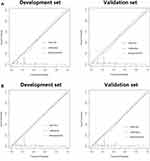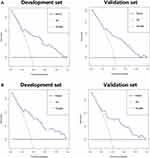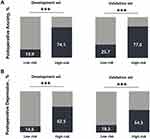Back to Journals » International Journal of General Medicine » Volume 15
Nomogram to Predict the Risk of Postoperative Anxiety and Depression in Colorectal Cancer Patients
Authors Hu Z, Zhang H, Wang J, Xiong H, Liu Y, Zhu Y, Chang Z , Hu H, Tang Q
Received 18 November 2021
Accepted for publication 27 April 2022
Published 12 May 2022 Volume 2022:15 Pages 4881—4895
DOI https://doi.org/10.2147/IJGM.S350092
Checked for plagiarism Yes
Review by Single anonymous peer review
Peer reviewer comments 2
Editor who approved publication: Dr Scott Fraser
Zhiqiao Hu,* Hao Zhang,* Jiaqi Wang, Huan Xiong, Yunxiao Liu, Yihao Zhu, Zewen Chang, Hanqing Hu, Qingchao Tang
Department of Colorectal Surgery, The Second Affiliated Hospital of Harbin Medical University, Harbin, 150081, People’s Republic of China
*These authors contributed equally to this work
Correspondence: Qingchao Tang, Department of Colorectal Surgery, The Second Affiliated Hospital of Harbin Medical University, 246 Xuefu Road, Harbin, People’s Republic of China, Tel +86-13945052628, Email [email protected]
Purpose: To develop and validate the risk nomogram to predict the likelihood of postoperative anxiety and depression in colorectal cancer (CRC) patients.
Methods: A total of 602 CRC patients from the Second Affiliated Hospital of Harbin Medical University were included in the study and divided into development set and validation set with the 2:1 ratio randomly. Logistic regression model was used to determine independent factors contributing to postoperative anxiety and depression, which were subsequently applied to build the nomogram for predicting postoperative anxiety and depression. The performance of the risk nomogram was appraised by the area under the receiver operating curve (AUC), calibration curves and decision curve analyses (DCA).
Results: Gender, personal status, income, adjuvant therapy, the Eastern Cooperative Oncology Group Scale (ECOG) score, comorbidity, postoperative complications and stoma status were significant indicators for postoperative anxiety and depression. The AUCs for the development and validation sets were 0.792 and 0.812 for the postoperative anxiety nomogram and 0.805 and 0.825 for the postoperative depression nomogram. Additionally, calibration curves and decision curve analyses also determined the reliable clinical importance of the proposed nomogram.
Conclusion: The current study constructed the risk nomogram for postoperative anxiety and depression and could help clinicians determine high-risk patients to some extent.
Keywords: nomogram, colorectal cancer, postoperative, anxiety and depression
Introduction
Globally, colorectal cancer (CRC) poses a major public health challenge because of its high incidence and mortality rate.1 With the consistent modifies and advances of therapeutic modality, the prognosis of CRC patients has notably improved during the past decade.2–4 However, mental distress secondary to the treatment seems to be an emerging challenge for us.5,6
According to previous studies, the prevalence of anxiety and depression among CRC patients ranged from 1.0% to 47.2% and 1.6% to 57.0%,7–9 respectively. Postoperative psychological disorder in the form of depression and anxiety is a relatively common phenomenon in the current clinical practice, which might reduce patient compliance with subsequent treatment, decrease the quality of life and result in a poor immune status. What is more, patients suffering from postoperative depression and anxiety are even associated with unfavorable long-term survival.10 The prevalence of postoperative psychological disorder in CRC patients has generally been influenced by clinical and demographic factors, such as gender, marital status, income, tumor stage and physical performance.11–14 Given that heterogeneous characteristics of different patients, how likely a patient could suffer from postoperative anxiety and depression is a crucial question for the regular monitoring and screening of postoperative anxiety and depression in CRC patients, which is of eminent significance for clinicians to perform prompt intervention.
Recently, nomogram is widely applied as a new method, which can quantify the risk of an outcome event by illustrating and incorporating important factors precisely.15,16 However, targeted nomogram for postoperative psychological disorder is still lacking. Therefore, the aim of this study was to develop and validate a nomogram to predict the likelihood of postoperative anxiety and depression in CRC patients.
Methods
Study Population
Colorectal cancer patients from the Second Hospital of Harbin Medical University between January 2013 and June 2018 were enrolled in the current research. Inclusion criteria included1 patients receiving radical resection,2 aged ≥18 years,3 patients diagnosed as stage I–III colorectal cancer pathologically,4 colorectal cancer was the only malignancy and5 patients realizing the severity of their disease. Exclusion criteria included1 patients with unknown data,2 patients with psychological or mental disease history (preoperative HADS score ≥8 points) and3 patients with neurological diseases or cognitive impairments and not being accurately capable of understanding daily questions. All patients are informed upon admission that all of their treatment-related information and the information we prospectively collect will be retained and may be used for scientific research. However, the information we collect will be kept strictly confidential and will not have any impact on the optimal treatment the patient receives. The Ethics Committee of the Second Hospital of Harbin Medical University agreed and approved this study. All procedures in this study conformed to the ethical standards of our institution and were in accordance with the Declaration of Helsinki.
Covariates
In accordance with previous studies, we used pre-established candidate indicators in order to avoid selection bias and overfitting.11–14 Additionally, all variables in the model should be readily available in the current practice attempting to improve its applicability. Therefore, sociodemographic features (personal status, income and education), health performance status (ECOG, comorbidity and postoperative complication), tumor stage, patient-related factors (gender and age) and treatment data (adjuvant therapy and stoma status) were reviewed. In this study, all cases were uniformly re-staged, according to the 8th edition of the American Joint Committee on Cancer (AJCC) and Union for International Cancer Control (UICC) staging system based on the pathological examination of surgical specimens. The Eastern Cooperative Oncology Group Scale (ECOG) was applied to assess the patient pre-treatment performance status.17 In order to evaluate the level of income satisfaction, a subjective 5-point scale was rated by the patients, and values of 4 and 5 were defined as satisfactory level.18 Postoperative complications were determined using the Clavien-Dindo criteria.19 The stratifications of the factors included were consistent with previous papers to make it more reasonable.11–14,20
Anxiety and Depression
The Hospital Anxiety and Depression Scale (HADS) was utilized to evaluate self-reported status of anxiety and depression.21 The HADS includes 14 items (7 items for anxiety symptom and 7 items for depression symptom). The score of each item ranged from 0 to 3 points and the total score ranged from 0 to 21 points for anxiety subscale and depression subscale. The higher points suggested the worse anxiety and depression status. According to previous studies, patients with 8–21 points were considered to be suffering from anxiety and depression.21–23 The preoperative questionnaire was performed the day before surgery, and the postoperative questionnaire was conducted by interview or phone at the follow-up 2 weeks after discharge.
Statistical Analysis
All patients were divided into development set and validation set with the 2:1 ratio randomly using the random number method in SPSS software. Logistic regression model was used to determine independent indicators contributing to postoperative anxiety and depression. Odds ratio (OR) with 95% confidence interval (CI) was posed as results. Factors with P < 0.05 in the multivariate analysis were subsequently chosen to build the risk nomogram. The maximum point of each indicator was set as 100. The performance of the nomogram was appraised by calibration curves, the area under the receiver operating curve (AUC) and decision curve analyses (DCA). P < 0.05 (two-sided) was defined as statistically significant. With the Youden’s index, the optimal cut-off risk scores for postoperative anxiety and depression have been calculated to help clinicians determine high-risk patients. All statistical analyses were performed using SPSS 22.0 and R version 3.6.1 software.
Results
Patient Characteristics
A total of 602 CRC patients were included in the study. After a random division, 401 patients (anxiety rate = 36.2, depression rate = 35.7%) were in the development set and 201 patients (anxiety rate = 41.3%, depression rate = 36.8%) were in the validation set. No significant difference could be found in age (P = 0.604), gender (P = 0.403), personal status (P = 0.673), income (P = 0.467), education (P = 0.534), UICC stage (P = 0.294), ECOG score (P = 0.922), comorbidity (P = 0.471), postoperative complication (P = 0.545), adjuvant therapy (P = 0.918) and stoma status (P = 0.615) between the two sets (Table 1).
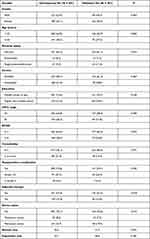 |
Table 1 Characteristics of Patients in the Development and Validation Sets |
Risk Factors Related to Postoperative Anxiety in the Development Set
Univariate analysis revealed the association between each factor and postoperative anxiety, including age (P = 0.516), gender (P = 0.027), personal status (for partnership, P = 0.113; for single/widowed/divorced, P = 0.000), income (P = 0.024), education (P = 0.857), UICC stage (P = 0.000), ECOG score (P = 0.004), comorbidity (P = 0.000), postoperative complication (for Grade 1/2, P = 0.011; for ≥ Grade 3, P = 0.014), adjuvant chemotherapy (P = 0.000) and stoma status (for temporary stoma, P = 0.004; for permanent stoma, P = 0.000). Multivariate analysis indicated that gender (OR = 2.335, 95% CI = 1.381–3.949 for female, P = 0.002; using male as the reference), personal status (OR = 1.834, 95% CI = 0.738–4.557 for partnership, P = 0.192; OR = 4.752, 95% CI = 2.018–11.190 for single/widowed/divorced, P = 0.000, using married as the reference), income (OR = 2.370, 95% CI = 1.381–4.068 for unsatisfied, P = 0.002, using satisfied as the reference), ECOG score (OR = 1.615, 95% CI = 1.121–2.631 for 2–4 points, P = 0.034, using 0–1 point as the reference), comorbidity (OR = 2.459, 95% CI = 1.364–4.432 for 2 or more, P = 0.003, using 0–1 as the reference), postoperative complication (OR = 1.538, 95% CI = 0.802–2.951 for Grade 1/2, P = 0.195; OR = 3.577, 95% CI = 1.034–12.369 for ≥ Grade 3, P = 0.044, using No postoperative complication as the reference), adjuvant chemotherapy (OR = 4.021, 95% CI = 1.788–9.044 for with adjuvant therapy, P = 0.001, using no adjuvant therapy as the reference) and stoma status (OR = 2.295, 95% CI = 1.251–6.804 for temporary stoma, P = 0.013; OR = 5.056, 95% CI = 2.473–10.339 for permanent stoma, P = 0.000, using no stoma as the reference) were the statistically significant predictors related to postoperative anxiety (Table 2).
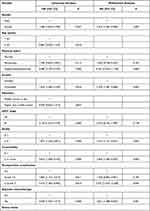 |
Table 2 Logistic Regression Analysis for Postoperative Anxiety in the Development Set |
Risk Factors Related to Postoperative Depression in the Development Set
Similarly, univariate analysis revealed the association between each factor and postoperative depression, including age (P = 0.350), gender (P = 0.002), personal status (for partnership, P = 0.050; for single/widowed/divorced, P = 0.000), income (P = 0.037), education (P = 0.857), UICC stage (P = 0.004), ECOG score (P = 0.002), comorbidity (P = 0.000), postoperative complication (for Grade 1/2, P = 0.004; for ≥ Grade 3, P = 0.011), adjuvant chemotherapy (P = 0.000) and stoma status (for temporary stoma, P = 0.001; for permanent stoma, P = 0.000). Multivariate analysis indicated that gender (OR = 3.390, 95% CI = 1.948–5.901 for female, P = 0.000; using male as the reference), personal status (OR = 2.484, 95% CI = 0.976–6.321 for partnership, P = 0.056; OR = 3.834, 95% CI = 1.639–8.967 for single/widowed/divorced, P = 0.002, using married as the reference), income (OR = 2.257, 95% CI = 1.307–3.898 for unsatisfied, P = 0.004, using satisfied as the reference), ECOG score (OR = 1.635, 95% CI = 1.026–2.790 for 2–4 points, P = 0.040, using 0–1 point as the reference), comorbidity (OR = 2.524, 95% CI = 1.379–4.620 for 2 or more, P = 0.003, using 0–1 as the reference), postoperative complication (OR = 1.670, 95% CI = 0.859–3.244 for Grade 1/2, P = 0.130; OR = 4.001, 95% CI = 1.119–14.310 for ≥ Grade 3, P = 0.033, using no postoperative complication as the reference), adjuvant therapy (OR = 2.664, 95% CI = 1.211–5.862 for with adjuvant therapy, P = 0.015, using no adjuvant therapy as the reference) and stoma status (OR = 3.880, 95% CI = 1.626–9.260 for temporary stoma, P = 0.002; OR = 6.251, 95% CI = 2.991–13.064 for permanent stoma, P = 0.000, using no stoma as the reference) were independent indicators for postoperative depression (Table 3).
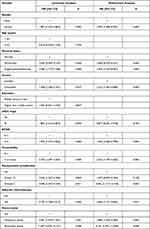 |
Table 3 Logistic Regression Analysis for Postoperative Depression in the Development Set |
Nomogram for Postoperative Anxiety and Depression
Subsequently, gender, personal status, income, adjuvant therapy, ECOG score, comorbidity, postoperative complication and stoma status were used to construct the risk nomogram for postoperative anxiety (Figure 1A) and depression (Figure 1B).
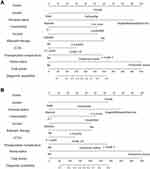 |
Figure 1 (A) Nomogram for postoperative anxiety. (B) Nomogram for postoperative depression. |
In terms of nomogram for postoperative anxiety, the AUCs of the development and validation sets were 0.792 (95% CI = 0.742–0.842) and 0.812 (95% CI = 0.747–0.877), respectively (Figure 2A). Regarding nomogram for postoperative depression, the AUCs of the development and validation sets were 0.805 (95% CI = 0.757–0.853) and 0.825 (95% CI = 0.764–0.887), respectively (Figure 2B). The calibration curves of nomograms for postoperative anxiety (Figure 3A) and depression (Figure 3B) also demonstrated good consistencies between predicted and observed rates in development and validation sets. In addition, DCA also indicated that the proposed nomograms for postoperative anxiety (Figure 4A) and depression (Figure 4B) owned excellent net benefits in guiding clinical decision in both sets.
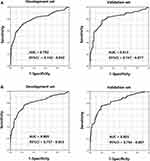 |
Figure 2 (A) ROC curves of the nomogram for postoperative anxiety in development and validation sets. (B) ROC curves of the nomogram for postoperative depression in development and validation sets. |
Besides, when the threshold probability was from about 20% to 100%, the use of the nomograms to predict postoperative anxiety and depression posed greater net benefit did “treat none” or “treat all” strategies in both development and validation sets, revealing the high effect and availability of the predictive nomograms.
Risk Stratification
Using the nomogram derived score for postoperative anxiety and depression, patients were stratified into low-risk group and high-risk group (anxiety: risk score >168, depression: risk score >123). From Figure 5A and B, we could easily find that patients in the high-risk group posed much higher level of postoperative anxiety and depression compared with those in the low-risk group in both development and validation sets.
Discussion
With an increasing population of CRC patients undergoing radical surgery, postoperative depression and anxiety could be a phenomenon desired to get attention. As an emerging research area, substantial indicators linked to depression- and anxiety-related disorders and symptoms are still inconsistent and limited in cancer-related studies. To our knowledge, this was the first study to develop and validate a risk nomogram to determine the risk of postoperative anxious and depression in CRC patients.
In recent years, there were some studies exploring the prevalence of anxiety and depression in CRC patients, while the results were varied. Sun et al found that the incidence of anxiety and depression were 32.5% and 6.6%.9 Mols et al revealed that the proportions of anxiety and depression patients were 20.9% and 19.0%, respectively.8 In the 602 patients of this study, 37.8% patients had postoperative anxiety and 36.0% patients suffered postoperative depression, which were higher than the results in the papers abovementioned.8,9 The possible reason accounting for this phenomenon was that all patients in this study received radical surgery, therefore increasing the trauma on them inevitably and subsequently making them more likely to develop anxiety and depression.
The present study showed that anxiety and depression were associated with gender (female), which was consistent with a large sample study that included 10,153 cancer patients and showed that the prevalence of anxiety and depression was higher in female cancer patients in all cancer types.11 Another study also performed a factor analysis of anxiety, depression and gender, and revealed that women were more prone to depression than men (P = 0.008) and gender was an independent influence on anxiety (P < 0.001).24 The potential reason accounting for this phenomenon might be that women tend to be less tolerant of malignant events than men and therefore more likely to develop depression and anxiety after surgical trauma.
Anxiety, depression and personal status (married, partnership and single/divorced/widowed) were also correlated in this paper. Compared with those married and having a partnership, single, divorced or widowed patients with malignancy may lack emotional support because the patients’ main emotional confidant is their spouse,25 and spouseless patients lack emotional support and catharsis, and have insufficient ability to cope with stress, leading to the increased susceptibility to anxiety and depression.12 This study showed that income was also associated with anxiety and depression. Similarly, one previous research conducted a univariate analysis of correlates of depression among colorectal cancer survivors who underwent resection, and income less than $30,000 was positively associated with depression screening (OR 2.20, 1.57–3.08 95% CI, P < 0.001), and multivariate analysis showed that low income was an independent influence on depression (OR 1.50, 1.02–2.22 95% CI, P = 0.04).13 A good economic status is a guarantee to meet the medical needs of patients. Patients with colorectal malignancies require a high cost of treatment, and patients with lower income levels need to bear a lot of financial pressure during the treatment process, which increases the psychological burden of patients, thus leading to anxiety and depression.26
What is more, consistent with previous studies,27,28 the need for adjuvant therapy was also a risk indicator for postoperative anxiety and depression. The application of adjuvant therapy could increase the financial burden and psychological stress due to uncertainty in treatment outcomes, putting patients at increased risk of postoperative anxiety and depression.27,28 The current study also revealed that preoperative performance status is a predictor of anxiety and depression. Patients with poor performance tend to be anxious and depressed, which is consistent with the results of other investigations.29
In this study, patients with stoma were associated with higher level of postoperative anxiety and depression. Similarly, an observational, cross-sectional study showed that patients with a stoma had higher levels of anxiety and depression than non-stoma patients (P < 0.05). Stoma surgery is a common treatment method for CRC patients, while it was found to be related to loss of normal anal function, distortion of body image and change in personal care, which was the main contributor to postoperative anxiety and depression.30 Also consistent with the research paper of Hellstadius et al, patients with higher grade postoperative complications are more likely to suffer from postoperative anxiety and depression, as a result of the longer duration of hospital stay and increased costs.31 Besides, the multivariate analysis showed that comorbidities were a predictor of anxiety and depression, which is consistent with a large sample of 1785 cases. This study also showed that two or more comorbidities (OR 1.78, 1.25–2.52, 95% CI, p = 0.001) were a strong predictor of depression in patients with colorectal cancer.13 Moreover, in a study of 2552 breast cancer survivors, Schoormans et al reported that comorbidities, specifically cardiovascular disease, negatively impacted quality of life, which in turn led to anxiety and depression.32
However, in this study, age and education level were not significant factors for postoperative anxiety and depression. Recently, the relationship between age and the prevalence of depression and anxiety has been explored widely, while the results are not consistent. Zhang et al and Nikbakhsh et al concluded that patients with older age are more likely to develop depression and anxiety.33,34 In contrast, Tavoli et al and Walker et al revealed that older patients were related to a lower level of depression and anxiety.35 And similar to what we found, Clark et al suggested that age was not a factor influencing the level of depression and anxiety.13 Therefore, the role of age playing in the development of postoperative depression and anxiety needs to be further determined by more scholars. Regarding education level, we found Clark et al achieved the same result that compared to patients with middle school or less education, those with higher education level did not pose different incidence of depression (OR = 0.97, 95% CI = 0.68–1.38, P = 0.850).13 Until now, no article has entirely determined the significance of education levels for anxiety and depression, and the impact of education levels on anxiety and depression still needs to be explored.
Therefore, gender, personal status, income, adjuvant therapy, ECOG score, comorbidity, postoperative complications and stoma status were applied to build the risk nomogram for. The AUCs for the development and validation sets were 0.792 and 0.812 for the postoperative anxiety nomogram, and 0.805 and 0.825 for the postoperative depression nomogram. Furthermore, calibration curves and decision curve analyses also determined the reliable clinical significance of the proposed nomogram.
Still, the authors acknowledged several study limitations. First, the results of the current study only reflect the characteristics of our department, but not the whole cohort, meaning that the predictive model needs to be validated by more external works. Secondly, as a retrospective study, it was inevitable to have selective bias and needed to be verified by some prospective clinical studies. Thirdly, we only assess the postoperative anxiety and depression level at the follow-up 2 weeks after discharge, but failed to monitor a dynamic change for these patients. Fourthly, other factors, such as hope, optimism and resilience, could not be analyzed in this study due to the lack of information.
Conclusion
This paper revealed gender, personal status, income, adjuvant therapy, ECOG score, comorbidity, postoperative complications and stoma status for postoperative anxiety and depression. Moreover, the risk nomogram based on these five factors could accurately predict the likelihood of anxiety and depression after surgery in CRC patients, which could subsequently help clinicians determine high-risk patients to some extent.
Data Sharing Statement
The data sets used and analyzed during the current study are available.
Ethical Statements
All patients are informed upon admission that all of their treatment-related information and the information we prospectively collect will be retained and may be used for scientific research. However, the information we collect will be kept strictly confidential and will not have any impact on the optimal treatment the patient receives. Patients provide informed consent for this. The Ethics Committee of the Second Hospital of Harbin Medical University agreed and approved this study. All procedures in this study conformed to the ethical standards of our institution and were in accordance with the Declaration of Helsinki.
Author Contributions
All authors made a significant contribution to the work reported, whether that is in the conception, study design, execution, acquisition of data, analysis and interpretation, or in all these areas; took part in drafting, revising or critically reviewing the article; gave final approval of the version to be published; have agreed on the journal to which the article has been submitted; and agree to be accountable for all aspects of the work.
Funding
There is no funding to report.
Disclosure
The authors declare no conflicts of interest to disclose in this work.
References
1. Siegel R, Miller K, Goding Sauer A, et al. Colorectal cancer statistics, 2020. Cancer J Clin. 2020;70(3):145–164. doi:10.3322/caac.21601
2. Maisonneuve P, Botteri E, Lowenfels A. Screening and surveillance for the early detection of colorectal cancer and adenomatous polyps. Gastroenterology. 2008;135(2):710. doi:10.1053/j.gastro.2008.04.039
3. Cukier M, Smith A, Milot L, et al. Neoadjuvant chemoradiotherapy and multivisceral resection for primary locally advanced adherent colon cancer: a single institution experience. Eur J Surg Oncol. 2012;38(8):677–682. doi:10.1016/j.ejso.2012.05.001
4. Taylor W, Donohue J, Gunderson L, et al. The Mayo clinic experience with multimodality treatment of locally advanced or recurrent colon cancer. Ann Surg Oncol. 2002;9(2):177–185. doi:10.1007/BF02557371
5. Gray N, Hall S, Browne S, et al. Predictors of anxiety and depression in people with colorectal cancer. Support Care Cancer. 2014;22(2):307–314. doi:10.1007/s00520-013-1963-8
6. Vodermaier A, Linden W, MacKenzie R, Greig D, Marshall C. Disease stage predicts post-diagnosis anxiety and depression only in some types of cancer. Br J Cancer. 2011;105(12):1814–1817. doi:10.1038/bjc.2011.503
7. Peng Y, Huang M, Kao C. Prevalence of depression and anxiety in colorectal cancer patients: a literature review. Int J Environ Res Public Health. 2019;16(3):411. doi:10.3390/ijerph16030411
8. Mols F, Schoormans D, de Hingh I, Oerlemans S, Husson O. Symptoms of anxiety and depression among colorectal cancer survivors from the population-based, longitudinal PROFILES registry: prevalence, predictors, and impact on quality of life. Cancer. 2018;124(12):2621–2628. doi:10.1002/cncr.31369
9. Sun L, Liang J, Lin C, Sun S, Kao C. Risk of mood disorders in patients with colorectal cancer. J Affect Disord. 2017;218:59–65. doi:10.1016/j.jad.2017.04.050
10. Zhu J, Fang F, Sjölander A, Fall K, Adami H, Valdimarsdóttir U. First-onset mental disorders after cancer diagnosis and cancer-specific mortality: a nationwide cohort study. Ann Oncol. 2017;28(8):1964–1969. doi:10.1093/annonc/mdx265
11. Linden W, Vodermaier A, Mackenzie R, Greig D. Anxiety and depression after cancer diagnosis: prevalence rates by cancer type, gender, and age. J Affect Disord. 2012;141(2–3):343–351. doi:10.1016/j.jad.2012.03.025
12. Piccinelli M, Wilkinson G. Gender differences in depression critical review. Br J psychiatry. 2000;177(6):486–492. doi:10.1192/bjp.177.6.486
13. Clark C, Fino N, Liang J, Hiller D, Bohl J. Depressive symptoms in older long-term colorectal cancer survivors: a population-based analysis using the SEER-Medicare healthcare outcomes survey. Support Care Cancer. 2016;24(9):3907–3914. doi:10.1007/s00520-016-3227-x
14. Simon A, Thompson M, Flashman K, Wardle J. Disease stage and psychosocial outcomes in colorectal cancer. Colorectal Dis. 2009;11(1):19–25. doi:10.1111/j.1463-1318.2008.01501.x
15. Wang C, Yang J, Zi H, et al. Nomogram for predicting the survival of gastric adenocarcinoma patients who receive surgery and chemotherapy. BMC Cancer. 2020;20(1):10. doi:10.1186/s12885-019-6495-2
16. Guan X, Ma C, Quan J, et al. A prognostic index model to individually predict clinical outcomes for colorectal cancer with synchronous bone metastasis. J Cancer. 2020;11(15):4366–4372. doi:10.7150/jca.40921
17. Abdel-Rahman O. ECOG performance score 0 versus 1: impact on efficacy and safety of first-line 5-FU-based chemotherapy among patients with metastatic colorectal cancer included in five randomized trials. Int J Colorectal Dis. 2019;34(12):2143–2150. doi:10.1007/s00384-019-03430-y
18. Majd M, Hashemian F, Younesi Sisi F, Jalal M, Majd Z. Quality of life and job satisfaction of dispensing pharmacists practicing in Tehran private-sector pharmacies. IJPR. 2012;11(4):1039–1044.
19. Clavien P, Barkun J, de Oliveira M, et al. The Clavien-Dindo classification of surgical complications: five-year experience. Ann Surg. 2009;250(2):187–196. doi:10.1097/SLA.0b013e3181b13ca2
20. Zhu L, Tong Y, Xu X, Xiao A, Zhang Y, Zhang S. High level of unmet needs and anxiety are associated with delayed initiation of adjuvant chemotherapy for colorectal cancer patients. Support Care Cancer. 2020;28(11):5299–5306. doi:10.1007/s00520-020-05333-z
21. Zigmond A, Snaith R. The hospital anxiety and depression scale. Acta Psychiatr Scand. 1983;67(6):361–370. doi:10.1111/j.1600-0447.1983.tb09716.x
22. Bjelland I, Dahl A, Haug T, Neckelmann D. The validity of the hospital anxiety and depression scale an updated literature review. J Psychosom Res. 2002;52(2):69–77. doi:10.1016/S0022-3999(01)00296-3
23. Olssøn I, Mykletun A, Dahl A. The hospital anxiety and depression rating scale: a cross-sectional study of psychometrics and case finding abilities in general practice. BMC Psychiatry. 2005;5(1):46. doi:10.1186/1471-244X-5-46
24. Hong J, Tian J. Prevalence of anxiety and depression and their risk factors in Chinese cancer patients. Support Care Cancer. 2014;22(2):453–459. doi:10.1007/s00520-013-1997-y
25. Goldzweig G, Andritsch E, Hubert A, et al. How relevant is marital status and gender variables in coping with colorectal cancer? A sample of middle-aged and older cancer survivors. Psychooncology. 2009;18(8):866–874. doi:10.1002/pon.1499
26. Lu L, O’Sullivan E, Sharp L. Cancer-related financial hardship among head and neck cancer survivors: risk factors and associations with health-related quality of life. Psychooncology. 2019;28(4):863–871. doi:10.1002/pon.5034
27. Jimenez-Fonseca P, Calderón C, Hernández R, et al. Factors associated with anxiety and depression in cancer patients prior to initiating adjuvant therapy. Clin Transl Oncol. 2018;20(11):1408–1415. doi:10.1007/s12094-018-1873-9
28. Lee M, Tyson D, Gonzalez B, et al. Anxiety and depression in Spanish-speaking Latina cancer patients prior to starting chemotherapy. Psychooncology. 2018;27(1):333–338. doi:10.1002/pon.4462
29. Chen M, Chang H, Yeh C. Anxiety and depression in Taiwanese cancer patients with and without pain. J Adv Nurs. 2000;32(4):944–951.
30. Cheung Y, Molassiotis A, Chang A. The effect of progressive muscle relaxation training on anxiety and quality of life after stoma surgery in colorectal cancer patients. Psychooncology. 2003;12(3):254–266. doi:10.1002/pon.638
31. Hellstadius Y, Lagergren J, Zylstra J, et al. A longitudinal assessment of psychological distress after oesophageal cancer surgery. Acta Oncol. 2017;56(5):746–752. doi:10.1080/0284186X.2017.1287945
32. Schoormans D, Czene K, Hall P, Brandberg Y. The impact of co-morbidity on health-related quality of life in breast cancer survivors and controls. Acta Oncol. 2015;54(5):727–734. doi:10.3109/0284186X.2014.998277
33. Zhang A, Cooper G. Recognition of depression and anxiety among elderly colorectal cancer patients. Nurs Res Pract. 2010;2010:693961. doi:10.1155/2010/693961
34. Nikbakhsh N, Moudi S, Abbasian S, Khafri S. Prevalence of depression and anxiety among cancer patients. Caspian J intern med. 2014;5(3):167–170.
35. Tavoli A, Mohagheghi M, Montazeri A, Roshan R, Tavoli Z, Omidvari S. Anxiety and depression in patients with gastrointestinal cancer: does knowledge of cancer diagnosis matter? BMC Gastroenterol. 2007;7(1):28. doi:10.1186/1471-230X-7-28
 © 2022 The Author(s). This work is published and licensed by Dove Medical Press Limited. The full terms of this license are available at https://www.dovepress.com/terms.php and incorporate the Creative Commons Attribution - Non Commercial (unported, v3.0) License.
By accessing the work you hereby accept the Terms. Non-commercial uses of the work are permitted without any further permission from Dove Medical Press Limited, provided the work is properly attributed. For permission for commercial use of this work, please see paragraphs 4.2 and 5 of our Terms.
© 2022 The Author(s). This work is published and licensed by Dove Medical Press Limited. The full terms of this license are available at https://www.dovepress.com/terms.php and incorporate the Creative Commons Attribution - Non Commercial (unported, v3.0) License.
By accessing the work you hereby accept the Terms. Non-commercial uses of the work are permitted without any further permission from Dove Medical Press Limited, provided the work is properly attributed. For permission for commercial use of this work, please see paragraphs 4.2 and 5 of our Terms.

